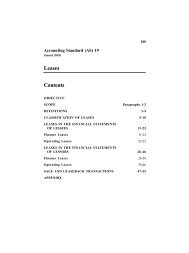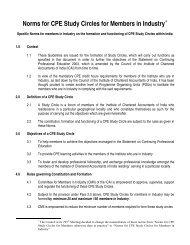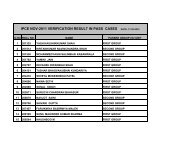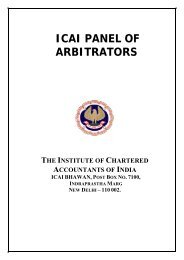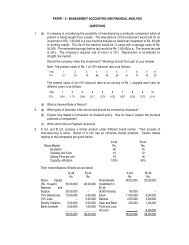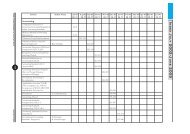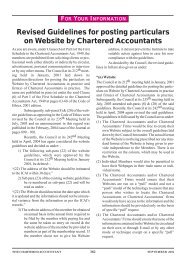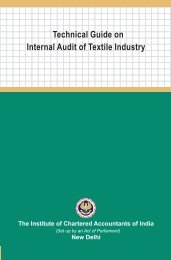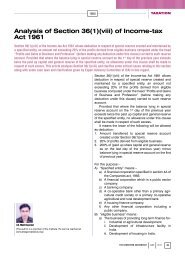The Chartered Accountant
The Chartered Accountant
The Chartered Accountant
Create successful ePaper yourself
Turn your PDF publications into a flip-book with our unique Google optimized e-Paper software.
on foreign currency borrowings<br />
is considered as borrowing<br />
costs to be accounted for<br />
under this Standard and the<br />
remaining exchange difference,<br />
if any, will be accounted<br />
for under Accounting Standard<br />
for Local Bodies (ASLB)<br />
on ‘<strong>The</strong> Effects of Changes<br />
in Foreign Exchange Rates’ 4 .<br />
For this purpose, the interest<br />
rate for the local currency<br />
borrowings is considered as<br />
that rate at which the entity<br />
would have raised the borrowings<br />
locally had the entity not<br />
decided to raise the foreign<br />
currency borrowings. Guidance<br />
on accounting for the<br />
effects of changes in foreign<br />
exchange rates can be found<br />
in Accounting Standard (AS)<br />
11, ‘<strong>The</strong> Effects of Changes<br />
in Foreign Exchange Rates’,<br />
until the ASLB on this subject<br />
is formulated.<br />
<strong>The</strong> application of this explanation is<br />
illustrated in the Appendix A.<br />
Economic Entity<br />
6. <strong>The</strong> term “economic entity” is<br />
used in this Standard to define, for<br />
financial reporting purposes, a group<br />
of entities comprising the controlling<br />
entity and any controlled entities.<br />
7. Other terms sometimes used to<br />
refer to an economic entity include<br />
“administrative entity”, “financial<br />
entity”, “consolidated entity” and<br />
“group”.<br />
8. An economic entity may include<br />
entities with both social policy and<br />
commercial objectives. For example,<br />
a local body XYZ (controlling entity)<br />
may control by way of majority<br />
voting power in an entity ABC (controlled<br />
entity) that provides services<br />
of health care for a nominal charge,<br />
4 <strong>The</strong> Accounting Standard for Local Bodies is under preparation.<br />
STANDARDS<br />
as well as another entity PQR (controlled<br />
entity) that provides transport<br />
services on a commercial basis. <strong>The</strong><br />
group of entities comprising local<br />
body XYZ and the controlled entities,<br />
viz., ABC and PQR, is the economic<br />
entity.<br />
Net Assets/Equity<br />
9. “Net assets/equity” is the term<br />
used in this Standard to refer to the<br />
residual measure in the balance sheet<br />
(assets less liabilities). Net assets/<br />
equity may be positive or negative.<br />
Other terms may be used in place of<br />
net assets/equity, provided that their<br />
meaning is clear.<br />
Qualifying Assets<br />
10. What constitutes a substantial<br />
period of time primarily depends on<br />
the facts and circumstances of each<br />
case. However, ordinarily, a period<br />
of twelve months is considered as<br />
substantial period of time unless a<br />
shorter or longer period can be justified<br />
on the basis of facts and circumstances<br />
of the case. In estimating<br />
the period, time which an asset takes,<br />
technologically and commercially, to<br />
get ready for its intended use or sale<br />
should be considered.<br />
11. Examples of qualifying assets are<br />
office buildings, hospitals, infrastructure<br />
assets such as roads, bridges<br />
and power generation facilities, and<br />
inventories that require a substantial<br />
period of time to bring them to a<br />
condition ready for use or sale, and<br />
investment properties. Other investments<br />
and those inventories that<br />
are routinely produced over a short<br />
period of time, are not qualifying assets.<br />
Assets that are ready for their<br />
intended use or sale when acquired<br />
also are not qualifying assets.<br />
Recognition<br />
12. Borrowing costs should be<br />
recognised as an expense in the<br />
period in which they are incurred,<br />
except to the extent that they are<br />
capitalised in accordance with<br />
paragraph 13.<br />
13. Borrowing costs that are specifically<br />
incurred for the acquisition,<br />
construction or production<br />
of a qualifying asset should be<br />
capitalised as part of the cost of<br />
that asset. <strong>The</strong> amount of borrowing<br />
costs eligible for capitalisation<br />
should be determined in accordance<br />
with this Standard.<br />
14. Borrowing costs are capitalised as<br />
part of the cost of a qualifying asset<br />
when it is probable that they will<br />
result in future economic benefits or<br />
service potential to the entity and the<br />
costs can be measured reliably. Other<br />
borrowing costs are recognised as an<br />
expense in the period in which they<br />
are incurred.<br />
15. When an entity borrows funds<br />
generally and uses them for the purposes<br />
of obtaining a qualifying asset,<br />
the entity recognises an expense for<br />
the borrowing costs in respect of<br />
such funds in the period in which<br />
they are incurred.<br />
Borrowing Costs Eligible<br />
for Capitalisation<br />
16. When an entity borrows funds<br />
specifically for the purpose of obtaining<br />
a particular qualifying asset,<br />
the borrowing costs that directly<br />
relate to that qualifying asset can<br />
be readily identified. Funds sourced<br />
from general borrowings of the entity<br />
are not specifically incurred and<br />
costs related to such borrowings are<br />
not eligible for capitalisation.<br />
17. Funds that have been borrowed<br />
centrally may be transferred to other<br />
entities within the economic entity as<br />
a loan, a grant or a capital injection.<br />
THE CHARTERED ACCOUNTANT 1081 DECEMBER 2008



